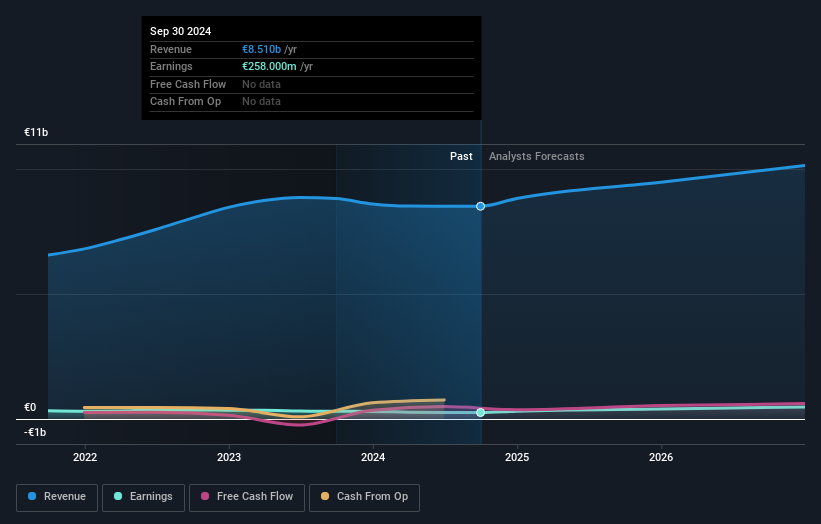Analysts Have Made A Financial Statement On PUMA SE's (ETR:PUM) Third-Quarter Report
PUMA SE (ETR:PUM) just released its latest quarterly report and things are not looking great. PUMA missed analyst forecasts, with revenues of €2.3b and statutory earnings per share (EPS) of €0.85, falling short by 2.6% and 4.8% respectively. Earnings are an important time for investors, as they can track a company's performance, look at what the analysts are forecasting for next year, and see if there's been a change in sentiment towards the company. We've gathered the most recent statutory forecasts to see whether the analysts have changed their earnings models, following these results.
Check out our latest analysis for PUMA

Taking into account the latest results, the consensus forecast from PUMA's 19 analysts is for revenues of €9.47b in 2025. This reflects a meaningful 11% improvement in revenue compared to the last 12 months. Per-share earnings are expected to jump 57% to €2.71. In the lead-up to this report, the analysts had been modelling revenues of €9.47b and earnings per share (EPS) of €2.69 in 2025. So it's pretty clear that, although the analysts have updated their estimates, there's been no major change in expectations for the business following the latest results.
There were no changes to revenue or earnings estimates or the price target of €50.47, suggesting that the company has met expectations in its recent result. That's not the only conclusion we can draw from this data however, as some investors also like to consider the spread in estimates when evaluating analyst price targets. There are some variant perceptions on PUMA, with the most bullish analyst valuing it at €85.00 and the most bearish at €39.00 per share. Note the wide gap in analyst price targets? This implies to us that there is a fairly broad range of possible scenarios for the underlying business.
One way to get more context on these forecasts is to look at how they compare to both past performance, and how other companies in the same industry are performing. It's pretty clear that there is an expectation that PUMA's revenue growth will slow down substantially, with revenues to the end of 2025 expected to display 8.9% growth on an annualised basis. This is compared to a historical growth rate of 13% over the past five years. By way of comparison, the other companies in this industry with analyst coverage are forecast to grow their revenue at 6.5% annually. Even after the forecast slowdown in growth, it seems obvious that PUMA is also expected to grow faster than the wider industry.
The Bottom Line
The most important thing to take away is that there's been no major change in sentiment, with the analysts reconfirming that the business is performing in line with their previous earnings per share estimates. Happily, there were no major changes to revenue forecasts, with the business still expected to grow faster than the wider industry. There was no real change to the consensus price target, suggesting that the intrinsic value of the business has not undergone any major changes with the latest estimates.
With that said, the long-term trajectory of the company's earnings is a lot more important than next year. We have forecasts for PUMA going out to 2026, and you can see them free on our platform here.
And what about risks? Every company has them, and we've spotted 1 warning sign for PUMA you should know about.
New: Manage All Your Stock Portfolios in One Place
We've created the ultimate portfolio companion for stock investors, and it's free.
• Connect an unlimited number of Portfolios and see your total in one currency
• Be alerted to new Warning Signs or Risks via email or mobile
• Track the Fair Value of your stocks
Have feedback on this article? Concerned about the content? Get in touch with us directly. Alternatively, email editorial-team (at) simplywallst.com.
This article by Simply Wall St is general in nature. We provide commentary based on historical data and analyst forecasts only using an unbiased methodology and our articles are not intended to be financial advice. It does not constitute a recommendation to buy or sell any stock, and does not take account of your objectives, or your financial situation. We aim to bring you long-term focused analysis driven by fundamental data. Note that our analysis may not factor in the latest price-sensitive company announcements or qualitative material. Simply Wall St has no position in any stocks mentioned.
About XTRA:PUM
PUMA
Engages in the development and sale of sports and sports lifestyle products in Germany, rest of Europe, the United States, North America, and internationally.
Good value with adequate balance sheet.
Similar Companies
Market Insights
Community Narratives





